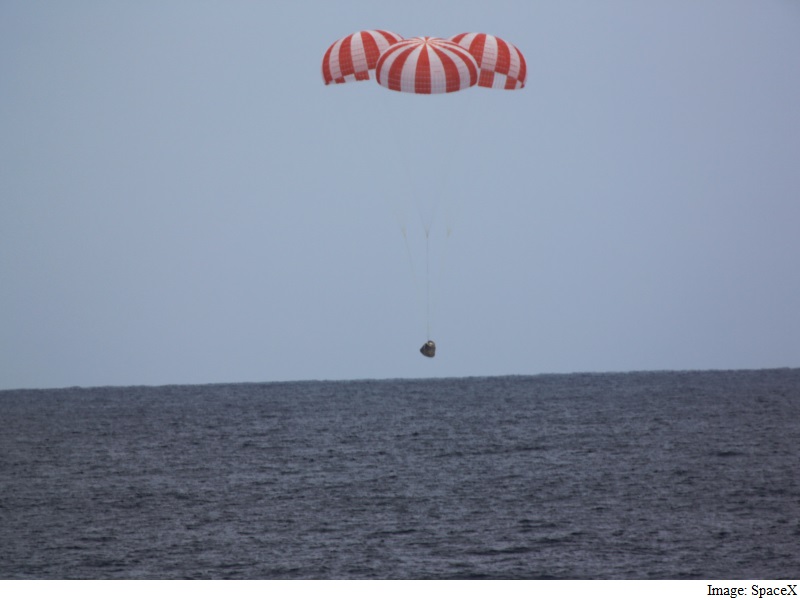- Home
- Science
- Science News
- SpaceX Dragon Cargo Capsule Splashes Down in Pacific Ocean
SpaceX Dragon Cargo Capsule Splashes Down in Pacific Ocean

It was the first return load from the station in a year, following a SpaceX launch accident in June 2015 that destroyed another unmanned Dragon capsule.
The company's Dragon capsules are currently the only ships that can return cargo from the station, a $100 billion research laboratory that flies about 250 miles (400 km) above Earth.
Space Exploration Technologies Corp, known as SpaceX, resumed Dragon flights to the station last month.
Ground controllers at Nasa's Johnson Space Center in Houston earlier on Wednesday used the station's robot arm to pluck the unmanned capsule from its berthing port and position it for release into space.
British astronaut Timothy Peake, working from inside the space station's cupola module, then commanded the crane to free its grip at 9:19 a.m. EDT/1319 GMT as the station sailed over Australia so Dragon could begin its ride back to Earth.
"Dragon spacecraft has served us well. It's good to see it departing full of science, and we wish it a safe recovery back on planet Earth," Peake radioed to Mission Control in Houston.
The capsule parachuted into the Pacific Ocean at 2:51 p.m. EDT/1851 GMT, splashing down about 260 miles (420 km) southwest of Long Beach, California.
Dragon's returning cargo includes more than 1,000 tubes of blood, urine and saliva samples from the one-year mission of former US astronaut Scott Kelly and Russian cosmonaut Mikhail Kornienko. The men returned to Earth in March.
Also aboard Dragon is the upper torso and life-support system of the faulty spacesuit Nasa astronaut Tim Kopra wore during a January spacewalk. The spacewalk was cut short when water began leaking into his helmet.
Nasa has had problems with leaking spacesuits before, including the near-drowning of Italian astronaut Luca Parmitano during a July 2013 outing.
Returning Kopra's spacesuit will allow engineers to better investigate the source of the water, Nasa spokesman Daniel Huot said.
Nasa plans to resume spacewalks after the next Dragon capsule arrives early this summer. The spaceship will carry a new docking system so that future crewed versions of Dragon, as well as Boeing's CST-100 Starliner, can park at the station.
Both capsules, developed in public-private partnerships with Nasa, are scheduled for test flights next year.
© Thomson Reuters 2016
Catch the latest from the Consumer Electronics Show on Gadgets 360, at our CES 2026 hub.
Related Stories
- Samsung Galaxy Unpacked 2025
- ChatGPT
- Redmi Note 14 Pro+
- iPhone 16
- Apple Vision Pro
- Oneplus 12
- OnePlus Nord CE 3 Lite 5G
- iPhone 13
- Xiaomi 14 Pro
- Oppo Find N3
- Tecno Spark Go (2023)
- Realme V30
- Best Phones Under 25000
- Samsung Galaxy S24 Series
- Cryptocurrency
- iQoo 12
- Samsung Galaxy S24 Ultra
- Giottus
- Samsung Galaxy Z Flip 5
- Apple 'Scary Fast'
- Housefull 5
- GoPro Hero 12 Black Review
- Invincible Season 2
- JioGlass
- HD Ready TV
- Laptop Under 50000
- Smartwatch Under 10000
- Latest Mobile Phones
- Compare Phones
- OPPO Reno 15 Pro Max
- Honor Win RT
- Honor Win
- Xiaomi 17 Ultra Leica Edition
- Xiaomi 17 Ultra
- Huawei Nova 15
- Huawei Nova 15 Pro
- Huawei Nova 15 Ultra
- Asus ProArt P16
- MacBook Pro 14-inch (M5, 2025)
- OPPO Pad Air 5
- Huawei MatePad 11.5 (2026)
- Xiaomi Watch 5
- Huawei Watch 10th Anniversary Edition
- Acerpure Nitro Z Series 100-inch QLED TV
- Samsung 43 Inch LED Ultra HD (4K) Smart TV (UA43UE81AFULXL)
- Asus ROG Ally
- Nintendo Switch Lite
- Haier 1.6 Ton 5 Star Inverter Split AC (HSU19G-MZAID5BN-INV)
- Haier 1.6 Ton 5 Star Inverter Split AC (HSU19G-MZAIM5BN-INV)

















